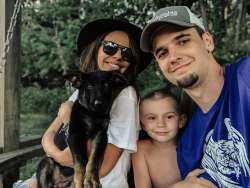by Jessica Smith
The Foundation for Biomedical Research’s Real Pet Stories series highlights the benefits of animal research by sharing the story of a child or an animal whose life was saved thanks to a treatment or medication developed thanks to animal research. Scientists perfected surgical techniques and procedures that saved Corbin’s life thanks to research with nonhuman primates and other animals. Corbin’s story underscores the benefits of animal research to protect the health and well-being of children and families.
A Parent’s Worst Nightmare
My 7-year-old son, Corbin, was brutally attacked by a teenager as he innocently played in our neighborhood park. We rushed Corbin to the emergency room at Riley Hospital for Children in Indiana, where the news didn’t get any better. The neurosurgeon and his team revealed Corbin’s only chance for survival — an emergency decompressive craniectomy. The news was devastating. Hearing that your son may not survive the night is a parent’s worst nightmare. Knowing the risks of the procedure, we proceeded with the surgery. In the end, the surgeons had to remove the entire right side of Corbin’s skull to stop the brain swelling and bleeding and to remove bone fragments from his brain.
Miraculously, our little guy pulled through the five-hour operation. After surgery he was placed in a medically induced coma. We were devastated to hear there would be a chance, due to the injuries sustained in the attack, that Corbin would never be the same. I refused to believe it. I just had this feeling, this feeling that my son would somehow pull through. And, you know what? He did. When he woke up in recovery, his first words were: “Can I have a McDonald’s milkshake?”
Initially, we were told to prepare for a long, difficult rehabilitation recovery. Corbin beat the odds again. He was released from the hospital and allowed to go home after five days. We returned three months later to have the bone flap replaced.
PEEK implant made possible through animal research saved Corbin’s life.
When Corbin had his bone flap replaced, it was discovered that his body was rejecting his own bone, which was removed during his initial surgery. We had to return for a third cranioplasty that involved fitting Corbin for a PEEK implant. Computer-designed, customized PEEK implants for cranioplasties are a practical alternative when a patient’s own bone grafts are not an option. PEEK implants would not be possible without animal research and testing. Implants such as Corbin’s are used in many procedures besides cranioplasties. You will find PEEK implants used in orthopedic, cardiovascular and dental procedures.
I learned that a family had a litter of German Shepherd puppies that needed good homes. I took Corbin (who did not know my plan was to let him adopt one) to see the puppies. One puppy immediately fell in love with Corbin. Corbin asked if we could keep the puppy, and I said yes! Of course, Corbin was overjoyed. That day we welcomed Marshall into our family. Ever since Marshall has been in Corbin’s life, I have seen my son’s confidence rise and his fear of being outside become less and less. Marshall is always by Corbin’s side, protecting him and loving him.
As Corbin continued to make a full recovery, his best friend Marshall continued to be by his side. He never left Corbin’s side, even as a very energetic puppy; Marshall had no problems being glued to Corbin as he made a full recovery.
It has now been four years since Corbin’s injury. He is a normal 11-year-old other than the scar on his head; he has shown relatively few adverse effects from the horrific injury he sustained. Although I have no way to prove it, I strongly believe his relationship with Marshall greatly helped him recover. The trauma Corbin endured was extensive for all of us. I know that having Marshall with him has helped him feel safer going outside to play again.
While Marshall is scared of his own shadow and prefers to be tucked into bed on top of a pile of pillows or carrying around his favorite toy, a stuffed Peppa Pig, he is Corbin’s best friend. And for that, I am truly grateful.
The Foundation for Biomedical Research shares stories like Corbin and Marshall’s to enlighten the public about the necessity of humane and responsible animal research to deliver treatments to children like Corbin. FBR also distributes educational materials and conducts public education campaigns to explain the role of animal research in biomedicine.





